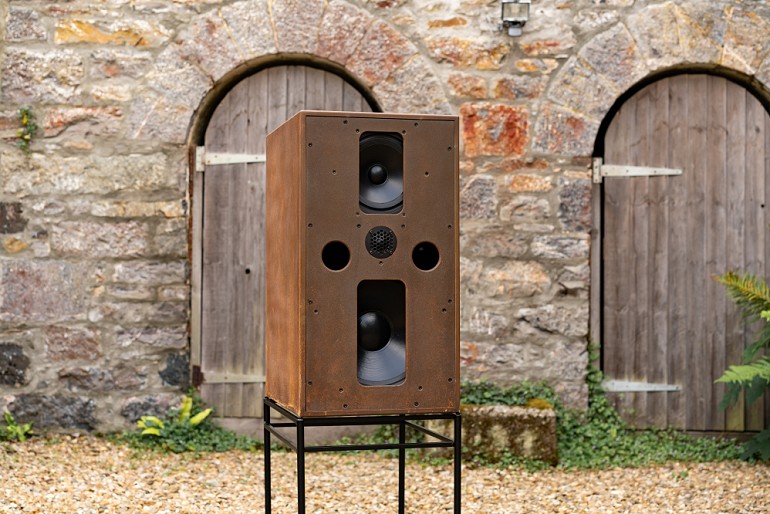
Mounting drive units behind slots
This technique is rarely seen today, but many decades ago it was widely used by the BBC and others. The results are surprisingly effective, but their operation is highly counter-intuitive.
What problems are the slots addressing?
At low frequencies, a drive unit will radiate sound widely. However, as you go up in frequency, the radiation pattern becomes more directional, like a spot light. The diameter of the diaphragm determines the frequency area where this takes place.
When performing or analysing loudspeaker measurements, it is natural to concentrate on the axial response - that is, the response measured with the microphone placed in front of the loudspeaker. However, in a listening room, you don't just hear the axial, or direct sound. Rather, what you hear is a mixture of the direct sound and the relected sound. This reflected sound might have emerged from the loudspeaker at an angle of, say, 45 degrees, before it hit the side wall and bounced off in your general direction. In practice, your ears will pick up many reflected versions of the direct sound - all arriving at slightly different times. It's remarkable that we are able to make any sense of it all, but the human hearing system is an amazing thing!
So as the overall impression you form when listening to a loudspeaker in a listening room is a product of both the direct and reflected sound, the designer must pay as much attention to the off-axis response as he or she pays to the direct, axial response. It also explains one of the reasons why two different loudspeakers with very similar axial responses can sound quite different to one another. And, perhaps surprisingly, this is something that BBC R&D were very much aware of back in the 1960s and before, when large (12 or 15 inches) drive units were the norm.
How the slot helps
It's easy to assume that a slot in front of a drive unit will make the radiation pattern become tighter. More focused, if you prefer. However - and this is the part that is non-intuitive - it actually does the opposite!
Placing a slot in front of a loudspeaker makes the unit behave like a smaller unit. In other words, the point at which it starts to become directional is changed to a higher frequency. This makes a useful difference to the off-axis response, and so in a room, you hear a smoother frequency response through the crossover region.
To explain further, let us consider the transition between the midrange drive unit and the tweeter. At low frequencies - say, 500Hz - the 8 inch midrange used in the LS5/5 will have a fairly broad radiation pattern, meaning that it will radiate energy in many directions, in a fairly even fashion. But as you go up in frequency - say, to 2kHz - the drive unit becomes more directional. Measured on-axis, the output level should still be healthy, but at 45 degrees away from this, the output will be substantially less. So at these sorts of frequencies, the ear is mostly hearing the sound directly, and the reflected sound will be missing a lot of energy by comparison.
But consider what happens at a higher frequency, such as 4kHz. Here the midrange driver is contributing much less and the bulk of the energy is coming from the tweeter. And of course, the tweeter has a much smaller diaphragm (only 1 inch), which is small relative to the wavelength of 4kHz (about 3½"). As a result, the tweeter radiates its sound widely - just like the mid-range was doing down at 500Hz.
So without the slot, there is a substantial dip in the total energy being generated by the loudspeaker in the mid-range region before the tweeter takes over. Subjectively, we might not be terribly bothered by the overall response falling away here, but we very definitely will notice the sudden arrival of the tweeter's off-axis contribution. Most people will perceive that as unwanted brightness or hardness, despite what the axial measurement tells us.
And of course, the LS5/5 is a three way design, so this also happens in the upper bass/lower midrange area because the 12 inch woofer is also suffering from the same increase in directivity at the upper range of its operation!
But great care must be taken to optimise these slots. If they are too narrow, there is a risk of resonances occuring between the rear of the front panel and the diaphragm. The ideal spacing between the baffle and the diaphragm (and the surround) must be carefully determined with detailed measurements. The thickness of the timber left after the machining operations is also critical. But having researched and built on the original work that went into the design of the LS5/5, we are left wondering why this approach isn't more commonly used today. Aside from the obvious aesthetic concerns, of course.
Conclusion
Adding the slots makes for a much smoother power response, which is the combination of the on-axis and off-axis frequency responses. A smooth power response leads to easier placement in typical listening environments.
Having demonstrated the new LS5/5 in a number of shows and events, we are well used to seeing the reactions of enthusiasts when they see the front of the LS5/5 for the first time. But, we are also accustomed to their reactions when they hear the design! Much as these slots go against all current conventions, they really do work.
